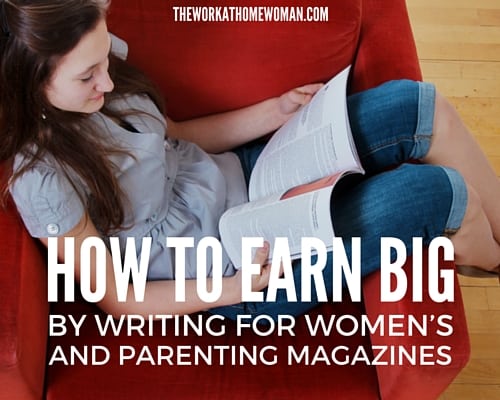You’re looking to work at home – or maybe you already do and are longing for an additional gig to fill in the financial gaps.
Sure, there are tons of writing jobs that advertise through bidding sites and content mills. And those are fine – if you don’t mind earning $10 per 1,00 words (or less).
But I have a better idea: How about writing for women’s and parenting magazines. After all, you are a woman, and you may be a parent, too. (And even if you don’t have a kid, don’t worry: I wrote for parenting magazines for 10 years before we had a kid of our own, and even some parenting magazine editors are child-free!)

The Rewards
Write what you know, share your experiences, help other women, and get fat checks in the mail. Does it get any sweeter?
Depending on who you write for, you can earn anywhere from $50 per article (for, say, a regional parenting mag) to $1,000 or more (for a feature for a newsstand magazine). My top-paid article weighed in at over $3,000. So there’s gold in them thar magazines!
Then there are the bylines. Seeing your name in a glossy magazine or in a well-known online publication is amazing – and seeing the title of an article you wrote splashed across the cover of a newsstand magazine can’t be beat.
The Drawbacks
Writing for women’s and parenting magazines can pay off, but it isn’t easy. The quality of your marketing and writing needs to be way beyond that expected at content mills and bidding sites.
For example, quality magazines expect you to send queries, which are sales letters describing your idea, your credentials, and why you and your idea are perfect for the publication.
Also: Some magazines, especially the larger ones, are known for their brutal editing process, where they require multiple revisions. And you usually don’t get paid until 30 days after the final draft is approved, so if you’re looking for fast cash, this isn’t it.
The Details
So I haven’t managed to scare you away, and you want to take a crack at landing gigs at women’s and parenting magazines. Great!
Here’s how to make that happen. Don’t freak over the amount of detail here. Take heart that the more queries you craft, the easier and quicker it will become.
So: To sell an article idea, you need:
1. A Market
A “market” is fancy journo-speak for a publication that pays writers and that you want to pitch.
Not sure whether a pub pays and if so, how much? Check guidelines on the pub’s website to see if they pay (if they don’t, they’ll often mention it), look at Writer’s Market, check out WhoPaysWriters.com, and ask other writers.
In general, the more well known the magazine, the more it pays. Parents will pay more than Chicago Parent. Woman’s Day will offer a bigger check than Orange County Woman. Also, print magazines typically pay more than online ones. Of course, there are always exceptions!
Especially at first, cast your net wide. Sure, pitch the big newsstand pubs, but don’t rely on them 100 percent, because they’re tough nuts to crack. If you want to make a good income writing for magazines, you’ll need to look beyond the bookstore, like on Google and in Writer’s Market, to find markets that are less competitive but still pay well. (There are thousands of them!)
For example, custom publishing companies create magazines (and blogs, and more) for their clients to use as marketing vehicles. You may find, for instance, that a baby formula company has a magazine aimed at moms, or an auto manufacturer has a mag for its female customers.
2. A Killer Idea
Become an observer of life. Watch what goes on around you and start jotting down article ideas based on your experiences.
Parenting and women’s magazines are service publications, meaning they offer how-to advice: How to discipline your kids, how to improve your relationships, how to deal with health issues, and so on. So listen to what your girlfriends are complaining about and problems you see discussed in women’s and parenting forums, and look for themes.
If you can solve a common problem with an article, that’s gold! For example, I noticed that many women’s forums were full of questions about periods, so I pitched – and sold – an article to Health magazine called “Your Period Problems – Solved.”
When considering your idea, editors will ask themselves three questions:
- Is it newsworthy/timely? (For example, is it based on an upcoming book, recent research, or something in the news?)
- Is it relevant to our audience? (If you want to write about a disease that affects only one percent of the magazine’s demographics, it probably won’t sell.)
- Is it unique? (Another article about how video games affect children? Yawn. How can you make your idea different from the others?)
Feeling stumped? Here’s some advice that will make you say “Duh!” but it’s incredible how many writers don’t follow it: Read the publications to which you plan to pitch.
Seeing what sells will help you avoid pitching ideas that have been done recently and give you a real-life lesson in how to angle an idea to make it fun and fresh. (Ever notice how so many women’s mags run “Walk Off the Weight” articles? They seem like they’re all the same, but not so: Walk off the weight – by walking backward! Walk off the weight – with intervals! Walk off the weight – by walking hills! Each article has a unique angle.)
3. A Compelling Query
A huge mistake I often see writers make is writing the query like it’s a business letter from the 1950s. A query is a writing audition, and you want the editor to be able to picture the article in her magazine after reading your pitch.
Reading your target markets will help you absorb the fun, conversational, occasionally edgy style used in these magazines. For example, when I pitched my article “The Better Orgasm Diet” to Redbook, I used words I often saw in the magazine, like “nix” and “zap,” as in “nix the caffeine” and “zap libido problems.” It sold!
Also, check out how your target magazine structures its articles and make your query an abbreviated version of that. For example, many parenting magazines like to start articles out with an anecdote from the writer (if she’s a parent) or from another mom, so you can start your pitch the same way.
Here’s the query format that has worked for me … almost unchanged for the last 20 years:
- The salutation can be “Dear Ms. James” or “Dear Jane.” I interviewed a handful of my editors on their preferences and most said they prefer to be addressed by their first name, but going formal will not cost you the sale.
- A lede (beginning) that emulates the ledes in the magazine.
- A nut graf (summary paragraph) that sums up why you’re writing, such as, “A 2016 study by X shows that 90 percent of parents have this same experience. In my article ‘Title,’ I’ll interview experts like Y and Z to tell your readers how they can solve this exasperating problem.”
- A couple examples of the advice you’ll be offering, formatted in a magazine-y style, such as with bullet points, with clever subheads, or in a fun chart. It’s helpful here to quickly reach out to a couple experts to get good advice and even a few killer quotes. (Service pieces for these magazines almost always include quotes from experts.)
- Your credentials. You probably have clips (examples of published writing), and you don’t even know it: Posts from your own blog, guest posts, and articles you may have written years ago are all fair game. If you’ve really never written for publication before, quickly mention anything else in your background that makes you the perfect person to write this piece. Are you an RD pitching a nutrition article? A mom of five pitching a parenting piece?
- The ask. I like to end my queries by asking for the sale. Common examples are “May I write ‘Title’ for you?” and “What do you think of this idea for Magazine? I look forward to your reaction!”
- Your sign off can just be “Regards,” “Cheers,” or whatever you normally use, then your full name, your phone number, and a link to your website or LinkedIn profile.
You’ll find lots and lots of blog posts, articles, books, and classes on query writing if you feel you need more details or handholding, but this is a basic format that works well.

4. Editor’s Name and Email Address
Please, please, please don’t send your query to a generic black-hole address like editor@ or letters@. And don’t tell me you can’t find the correct editor’s name and email address. I’ve had writing students complain on class calls that they couldn’t locate the info, and I would find it in about five seconds right there on the call.
Here are some options: Check the magazine’s masthead (list of editors). Google “editor at X magazine.” Ask around in writers’ forums. Check a directory like Writer’s Market. Use one of the many email verification sites and plug in your best guess at the editor’s email address (like [email protected], [email protected], etc.). Reach out to the editor on LinkedIn or Twitter and ask for her email address for queries. Call the magazine or the publication group (yes, you can do this!) and ask.
5. Guts and Persistence
Let me tell you right now: You will experience rejection. Likely lots of it. I’ve gotten well over 500 rejections in my career, and yet managed to make a pretty good living writing for magazines for close to two decades.
The mediocre writer who is persistent will always do better than the great writer who never sends out her queries because they’re not “perfect” enough. Decide when your pitch is good enough, hit send, and move on to the next one.
Even better, come up with queries that can be sent, with a little tweaking, to multiple magazines at once. (In separate emails, of course.) It’s a numbers game: Your hit rate at first is likely to be low, so you want to get out as many queries as you can. Many editors these days don’t respond if they’re not interested, so if you wait to get a response on each query before sending your pitch elsewhere, your idea may go stale before it sells.
When you start developing relationships with editors, then you can give them an exclusive look at your ideas before sending them around to others. But until then, you have to look out for number one. (Psst … that’s you.)
6. Follow Up
Finally, follow up. It’s not a requirement, but I find that politely persistent writers get more assignments. Wait a week or two, then send a polite reminder email with your original query pasted underneath.
If the editor is interested, she’ll email with an assignment. Nail down the word count, deadline, pay, and payment terms – then start writing!
Linda Formichelli has written for more than 150 magazines, from Pizza Today to Parenting to Family Circle. She also writes books. Her newest is How to Do It All: The Revolutionary Plan to Create a Full, Meaningful Life — While Only Occasionally Wanting to Poke Your Eyes Out With a Sharpie, which tells women how to live their best life by sleeping less, showering less, being inconsistent, and bucking the status quo. Check out the book here.






I want to start my carrier or new journey as a writer
I very excited and interested to start writing
I am interested to start my career as a writer
I’m interested to start my career with writing
Check out these posts for getting started:
https://www.theworkathomewoman.com/start-working-from-home-now/
https://www.theworkathomewoman.com/paid-writing-gigs/
https://www.theworkathomewoman.com/freelance-fees/